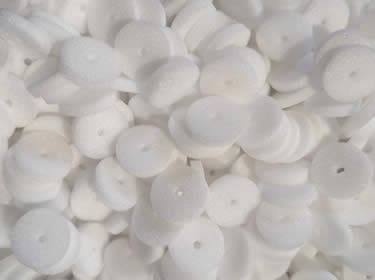Plastazote LD33


Plastazote LD33: Lightweight, Durable, and Versatile Closed-Cell Foam
Call 0121 544 5808 Today
Bespoke Manufacturing
Instant Quote Service
Worldwide Delivery
Various Gauges/Thicknesses
Bespoke Manufacturing
Instant Quote Service
Worldwide Delivery
Various Gauges/Thicknesses
What is Plastazote LD33?
Plastazote LD33 is a low-density, closed-cell, cross-linked polyethylene foam, part of the Zotefoams family, known for its lightweight, flexible, and durable properties.
- Density: Approximately 33 kg/m³, which makes it softer and more flexible than higher-density foams.
- Key Features: Lightweight, impact-resistant, chemically inert, non-absorbent, and hypoallergenic.
Benefits of Plastazote LD33
Plastazote LD33 offers several advantages that make it a popular choice across industries:
1. Lightweight:
With a low density of 33 kg/m³, Plastazote LD33 is easy to handle, transport, and install in applications requiring minimal added weight.
2. Impact Resistance:
The foam’s closed-cell structure provides excellent shock absorption, making it perfect for protective applications in packaging, sports gear, and automotive padding.
3. Durable and Long-Lasting:
Its ability to maintain flexibility and cushioning properties over time ensures durability, reducing the need for frequent replacements.
4. Water Resistance:
The closed-cell nature prevents water absorption, making it ideal for applications exposed to moisture or humidity, such as packaging or environmental sealing.
5. Chemical Resistance:
Plastazote LD33 is resistant to many chemicals, oils, and solvents, making it suitable for industrial applications.
6. Hypoallergenic and Safe:
Non-toxic and hypoallergenic, making it suitable for medical applications like splints, supports, and prosthetics.
7. Thermal Insulation:
With low thermal conductivity, it is effective in maintaining stable temperatures, making it ideal for packaging sensitive equipment and insulating interiors.
8. Ease of Fabrication:
Easily cut, shaped, and bonded, offering flexibility for custom moulding, packaging, and creative projects like props or prototypes.
9. Environmentally Friendly:
Often recyclable, produced using a nitrogen expansion process that is more eco-friendly compared to traditional foam manufacturing methods.
10. Cost-Effective:
Its durability, versatility, and lightweight nature make it a cost-effective choice for applications requiring long-term use, particularly in packaging, protective equipment, and medical devices.
Applications of Plastazote LD33
Plastazote LD33’s versatility allows it to be used in various industries for a wide range of applications:
Common Challenges of Plastazote LD33 (Painhooks)
While Plastazote LD33 is highly versatile, it has certain limitations:
- Limited Load-Bearing Capacity:
As a low-density foam, Plastazote LD33 is soft and compresses under weight, making it unsuitable for applications requiring high structural support. - Deformation Under High Pressure:
Prolonged compression can cause permanent deformation, reducing its effectiveness in applications needing consistent cushioning over time. - Low Heat Resistance:
It is not suitable for high-temperature environments, as exposure to temperatures above 90°C can cause the foam to melt or deform. - Limited Chemical Resistance:
While resistant to many chemicals, certain solvents and oils can degrade Plastazote LD33 over time, restricting its use in some industrial settings. - Not Suitable for Extreme Outdoor Conditions:
Extended exposure to UV rays or harsh weather can lead to degradation, making it less suitable for outdoor use without additional protection. - Higher Cost Compared to Other Foams:
Plastazote LD33 is more expensive than basic foam materials like open-cell foams, which may be a drawback for budget-conscious projects. - Aesthetic Limitations:
The industrial appearance may not meet design or aesthetic standards for consumer-facing products. - Difficulty in Recycling:
While recyclable, specialised recycling facilities are required, and not all regions may have access to them. - Specialised Handling Required:
Some applications require specialised adhesives or bonding techniques, increasing manufacturing time and costs.
Industry-Specific Materials Used in Manufacturing
Different industries use specific materials based on their needs, performance, and applications.
Here’s a look at commonly used materials in various sectors:
- Metals:
Steel, Aluminum, Stainless Steel, Copper, Titanium: Used for their strength, durability, and corrosion resistance in industries such as automotive, aerospace, and construction. - Plastics and Polymers:
Polyethylene (PE), Polypropylene (PP), PVC, ABS, Nylon: Flexible, lightweight, and chemically resistant, these are used in packaging, automotive components, and industrial parts. - Rubbers and Elastomers:
Natural Rubber, Neoprene, EPDM, Silicone, Viton®: Known for flexibility and resistance to wear, heat, and chemicals, used in seals, Gaskets, and insulation. - Composites:
Fibreglass, Carbon Fiber, Kevlar®: Combine strength with lightweight properties, used in aerospace, automotive, and protective gear. - Foams:
Polyurethane Foam, Polyethylene Foam (Plastazote), EPS: Used in packaging, cushioning, and insulation applications. - Ceramics:
Alumina, Silicon Carbide, Zirconia: High-temperature resistance and hardness, used in electronics, aerospace, and medical fields. - Textiles:
Cotton, Polyester, Kevlar®: For strength, flexibility, and durability, used in clothing, protective gear, and industrial applications. - Adhesives and Sealants:
Epoxy Adhesives, Silicone Sealants, Polyurethane Adhesives: Used for strong bonding and waterproofing across industries.
FAQs About Plastazote LD33
What is Plastazote LD33?
What are the main applications of Plastazote LD33?
Why is Plastazote LD33 used in protective packaging?
Can Plastazote LD33 be used in outdoor environments?
Is Plastazote LD33 safe for medical applications?
What are the limitations of Plastazote LD33?
Can Plastazote LD33 be customised for specific applications?
How does Plastazote LD33 compare to other foams?
Is Plastazote LD33 recyclable?
What industries benefit most from using Plastazote LD33?
Conclusion
Plastazote LD33 is a highly versatile and durable closed-cell foam that delivers exceptional performance across industries, from medical to packaging, aerospace, and automotive. Its lightweight nature, impact resistance, and chemical resilience make it an ideal choice for applications requiring long-term durability and safety.
At Stephens Gaskets, we specialise in providing Plastazote LD33 tailored to your specific needs.
